aether architecture - Mediated
Spaces
Mediated Spaces – extending architecture and its territory
MSc in Architecture thesis by Adam Somlai-Fischer
Supervisors: Ana Betancour + Peter Hasdell / A + URL
2002 December
For further information please visit the detailed project website:
http://www.arch.kth.se/mediatedspaces
The perceived reality
“What we perceive as reality is a tiny detail from the field
of possibilities surging around us, which our nervous system has realized
through computation. If all reality is a computation from possibilities,
then "reality" is a threshold value”
[Vilém Flusser]
Electronic media saturate our cultural environment, so influence our perceived reality(1). Think about how many things you have seen for real, and how many on images and film. Today, it becomes unavoidable for architects to look at these issues more carefully.
I wanted to start from scratch, to test new possibilities for real, asking what new architecture could arise from our rapidly developing environment.
For this reason, I have decided not to draw plans and sections, as in a regular architecture project using representational methods, but to build prototypes, in a 1 to 1 scale, that are testing the possibilities of blurring the electronic media into the physical space.
Building functioning installations instead of drawing plans and sections, requires different resources in knowledge and materials. I have acted throughout the project as a "plugin" or parasite with my specific interests, and was traveling through a set of events and platforms, ranging from academic to commercial and cultural. This allowed me to collaborate with people having various backgrounds, from different disciplines. For this, specific credits are carefully noted at each prototype.
Method of research
The project is highly influenced by ideas from complexity science(2). I wanted it to develop into a network of connected parts, rather than a main result, a singular outcome. This system of seven prototypes in the end, is communicating via the underlying concepts, through the designer-mediator.
The project was developed in a distant working collaboration over the Internet with Kerstin Nigsch from TU Vienna architecture. Using an online library called reBrain (http://www.arch.kth.se/eurb/rebrain/) made it possible to keep track of each others progress and invite others to read and interact with the project.
As a general concept, I am trying to give physical qualities to mediated experiences and mediate physical environments, to blur the threshold in-between. To make this more clear, I would like to briefly introduce four of the Prototypes.
Architecture as media
The social habits for an architecture as media are already existing with the use of mobile phones, Internet, and so on. This condition makes these issues relevant for architects, looking into how material qualities can be extended through media and how this can mediate local spaces to distant spaces.
The seven prototypes
The project is carried out through the making of seven instrumental
prototypes, that are testing concepts and experiences in a 1 to 1 scale,
and are forming a rhizomatic system, informing each other back and forth.
The method has been re-appropriating already existing concepts and technology
in a playful way to breed new experiences. These prototypes are:
| Satellite Algorithms Spaces of algorithmic motion are linked to physical devices. Media: 21Kb, Flash, Electrograph, Sound |
|
| Screen Threshold Giving physical qualities to a mediated entity, blurring the threshold. Media: 50*50 cm, 41Kb, Flash, CRT Screen, Deconstructed Mouse, Magnetism, Wind |
|
| Backpack Dance Biofeedback instrument mediating music to dance. 20 testers personal behavior documented. Media: Gives physical qualities to music 30*50 cm, 6Kb, Music, icrocontroller, Radio, People |
|
| Installation for Learning Lab Taking the backpack experience to a communal level. Media: 80 m2, 200Mb, Sound showers, lights, Kodály hand signs, solmization |
|
| The Responsive Octopus Informing a virtual space with qualities of a physical model. Media: 40Kb, Steel, Flash |
|
| Remote Home Mediation of two small architectural spaces. Compound of previous ideas on a communal level. Media: 20m2, 4000Kb, Flash, Mouse, Keyboard, Projection, Sound, Milk, Fabric, Steel, Aluminum, |
|
| Memory Scan Mediation of a cultural space. Media: 150 m2, Computers, Keyboards |
Collaborators for the prototypes: Kerstin Nigsch, Tobi Schneidler, Magnus Jonsson, Nagy Peter Sándor, Pozna Anita, Olivier Frances, German Bender Pulido, Martin Larsson. For specific credits please visit the project website.
Screen Threshold is an interactive installation created for an exhibition
in Stockholm's Cultural House. The installation consists of two main sides
- a small virtual creature, that is dancing behind the screen, reacting
to physical forces coming from the outside. This was made possible through
a device attached to the glass on the other side, so the visitor can blow
on it, switch it, magnetise it. This very direct attack on the virtual
side resulted in something mesmerising, the small tangible environment
became one with the media, the glass threshold of the screen became blurred.
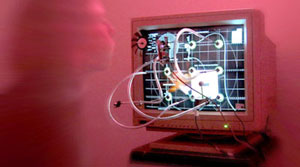
To extend the experience of this prototype, the next aim became to open
up this threshold, to get into this space that lies between the physical
device and the dance of the satellite.
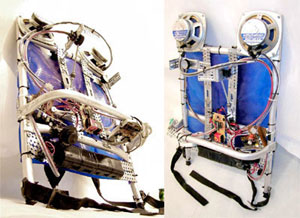
This setup is not new, but with a specific interest, this prototype built
with Kerstin Nigsch from Austria resulted in very interesting experience.
We have developed a backpack, that turns the dance of the person wearing
it into music, a biofeedback instrument. We have tested and documented
on 20 people from the streets of Vienna and Budapest. Something that today
is more and more defined by remote stations, is generated by the physical
movement of your own body.
Giving the concept a twist, the 5th prototype is a virtual space designed
through physical modeling, by informing the virtual with qualities of
the physical model. This structure could function as a navigation system
for a website for an architecture practice in Madrid, so we could develop
it there.
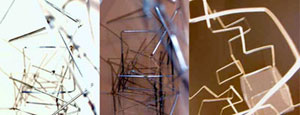
This prototype could be considered as a compound of the previous work
in many ways, where parts and results from previous prototypes are brought
together. It is called remote home, and tests the mediation of two small
architectural spaces into each other. It was set up in the Fisher gallery
in Seattle.
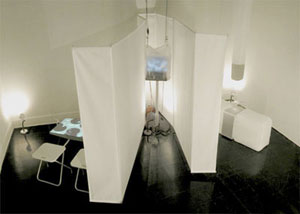
The setup of the exhibition: London - Virtual space - Berlin. An old
laptop hanging in the middle is running the whole installation using Flash.
With foldable and inflatable techniques, the whole installation could
fit as our personal luggage on the airliner
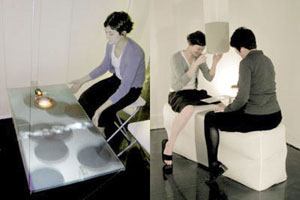
The Interactive Lounge Table in London and the Sound Shaft in Berlin -
disassembled mouse and keyboard
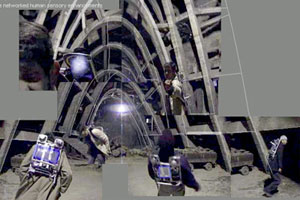
A larger scale scenario of extending an old space with new media